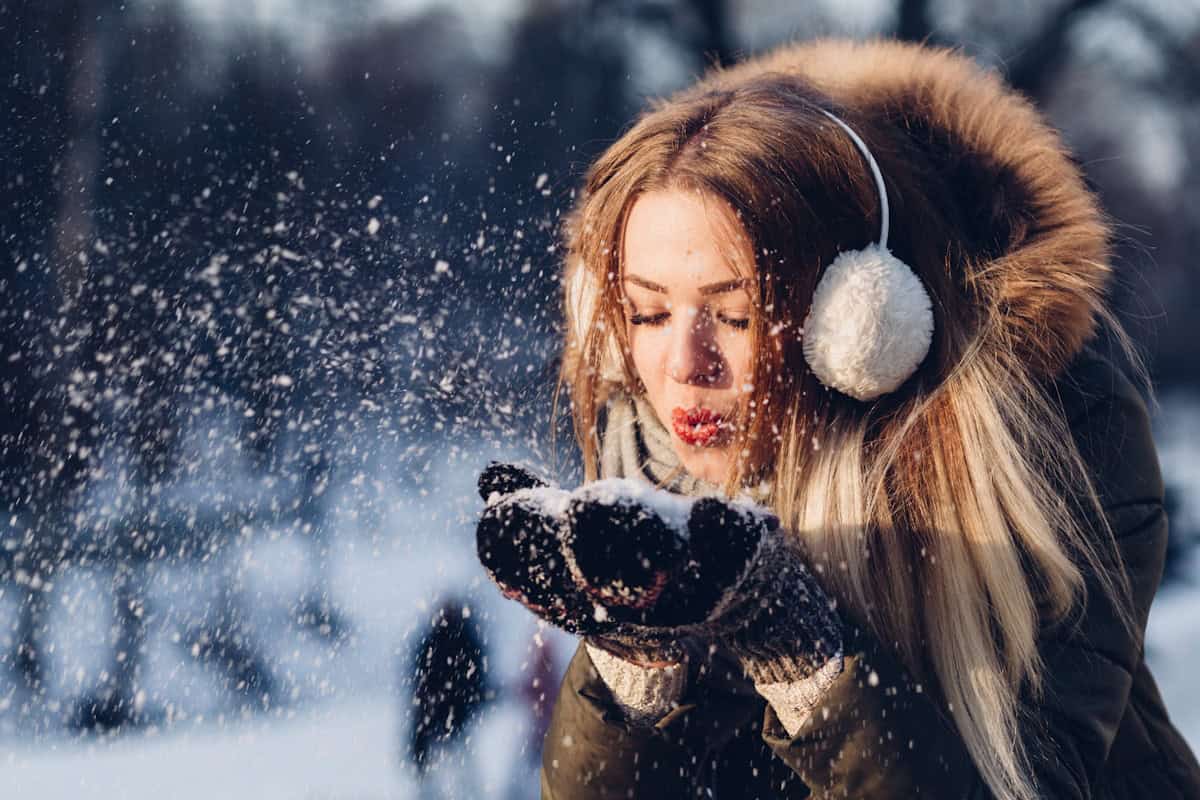
10 Snowy Adventures for the Perfect Winter Getaway
By: Frayed Passport
Skip to Section
Most people plan vacations around sunshine and warm beaches. But winter? Winter hits different when you lean into it instead of running from it.
Cold-weather adventures offer something beach trips can’t touch: that sharp, crisp air that wakes you up, the quiet crunch of fresh snow underfoot, and the kind of cozy evenings by the fire that you’ll remember for years. If you’re tired of the same old tropical getaway, a snowy adventure might be exactly what you need.
The best part? Winter trips come in all shapes and sizes. You can go full survival mode with backcountry camping, find your zen on snowshoes, or hole up in a cabin with hot chocolate and a good book. Here are some of the best ways to make winter your new favorite travel season.
Winter Camping in National Parks
Summer camping is crowded. Winter camping is yours alone.
Yellowstone transforms into a completely different park once snow begins to fall. The geysers steam dramatically against white backdrops, bison wade through snowdrifts, and you might see maybe a dozen other people all day. The park keeps some roads open for snowcoaches and snowmobiles, giving you access to backcountry sites without the summer mobs.
You’ll need serious cold-weather gear – a four-season tent, a sleeping bag rated to at least 0°F, and insulated sleeping pads. But waking up to a frozen wonderland with zero crowds makes the extra effort worthwhile.
Yosemite also opens select campgrounds in winter. The waterfalls freeze into ice sculptures, and Half Dome is dusted with snow, making it look even more dramatic than usual.
Just know what you’re getting into. Winter camping is cold, sometimes brutally so. If you’ve never done it, start with a single night close to home before committing to a week in the wilderness.
Backcountry and Heli-Skiing Adventures
Resort skiing is fine, but the best powder is where the crowds aren’t.
Backcountry skiing takes you into untracked snow far from groomed runs. You earn your turns by hiking uphill with skins on your skis, then get rewarded with fresh lines through untouched terrain. Colorado’s 10th Mountain Division Hut System connects backcountry cabins across the Rockies, letting you ski hut-to-hut through pristine wilderness.
For the ultimate splurge, heli-skiing packages drop you on remote peaks via helicopter. British Columbia pioneered the concept and still offers some of the world’s best heli-skiing. You’ll ski thousands of vertical feet of powder in places most people never see.
Fair warning: both options require solid skiing skills and avalanche safety training. These aren’t beginner trips. But if you’re comfortable with black diamonds and tired of lift lines, they’ll ruin regular resort skiing for you forever.
Snowshoeing Through Quiet Mountains
Snowshoes turn every snowy trail into your personal path.
Most ski resorts rent snowshoes for around $20-30 a day, but the trails they access stay nearly empty. While everyone else fights for lift access, you’ll be wandering through silent forests with nothing but your footprints in the snow.
Lake Tahoe has dozens of snowshoe trails ranging from easy lakeside walks to challenging mountain climbs. The winter landscape here looks completely different from summer – quieter, simpler, almost meditative.
Rocky Mountain National Park keeps several roads closed to cars in winter, opening them up to snowshoers. You can snowshoe right up the middle of Trail Ridge Road with zero traffic.
The beauty of snowshoeing is that it requires almost no skill. If you can walk, you can snowshoe. Strap them on and go.
Cross-Country Skiing for the Full-Body Workout
Cross-country skiing will humble you in the best way possible.
Unlike downhill skiing, cross-country skiing uses your whole body. Your legs push, your arms pole, your core stabilizes, and by the end, you’ll understand why Nordic skiers are some of the fittest athletes on earth. The first day will destroy you. On the second day, you’ll start to get it.
The Boundary Waters in Minnesota becomes a cross-country paradise in winter. The same lakes you’d paddle in summer freeze solid, creating miles of flat skiing with forest views on all sides.
The Methow Valley in Washington boasts over 120 miles of groomed cross-country trails, one of the largest networks in North America. The valley is situated on the east side of the North Cascades, receiving more sun and less rain than Seattle, while still experiencing ample snowfall.
Most Nordic centers offer lessons and rentals. Take the lesson. Cross-country looks easier than it is, and proper technique makes a massive difference.
Buying the right gear and accessories for your adventure starts with having stable, comfortable boots and lots of layers. Choose skis and poles that match your skill level and the type of skiing you plan to do – and of course if you’re not sure, just ask the store what they recommend!
Ice Climbing for the Adrenaline Seekers
Climbing frozen waterfalls feels like science fiction until you try it.
Ice climbing combines rock climbing’s problem-solving aspects with the added challenge of navigating temporary terrain. The ice you’re climbing formed this winter and will melt by spring. Your holds are ice screws you place yourself. Everything feels more precarious and more thrilling.
Ouray, Colorado built an entire ice park just for climbing. They spray water on the canyon walls to form reliable ice climbs from December through March. It’s one of the few places where beginners can safely try ice climbing with proper instruction and guidance.
The Adirondacks in New York offer more backcountry ice climbing for experienced climbers. Frozen waterfalls throughout the region create natural climbing routes.
You’ll need a guide on your first time. Ice climbing is inherently more dangerous, and the gear and techniques differ significantly from those used in rock climbing. But few winter activities match the rush of pulling yourself up a frozen waterfall.
Dog Sledding in Alaska
Riding behind a team of huskies checks a box you didn’t know was on your bucket list.
Alaska offers everything from short introductory rides to multi-day expeditions. Some outfitters allow you to drive your own sled after receiving instruction. Others have you ride as a passenger while experienced mushers handle the team.
The dogs are the real stars. They live for running in the snow, and their enthusiasm is infectious. Watch them lose their minds with excitement when they realize it’s time to harness up.
Minnesota and Michigan’s Upper Peninsula also offer excellent dog sledding options if Alaska feels too far away. The experience is remarkably similar – silence except for the sound of runners on snow and the padding of dozens of paws.
Most trips include time to meet the dogs, learn about mushing culture, and hear stories about the Iditarod. The sport has a deep history in cold-weather regions, and good guides share that context.
Northern Lights Hunting
Seeing the aurora borealis in person can be a profoundly transformative experience.
The Northern Lights dance across the sky in green, purple, and pink waves that photos can’t capture. You have to see it moving, shifting, flickering to understand why people travel thousands of miles for it.
Fairbanks, Alaska sits directly under the aurora oval, giving it some of North America’s best viewing odds. Go between late September and early April for the longest nights. Book a heated cabin or yurt so you can run inside to warm up between viewing sessions.
Churchill, Manitoba combines northern lights with polar bear viewing if you visit in October or November. The town sits on Hudson Bay, where bears congregate waiting for the ice to form.
Northern Norway and Iceland offer easier access from Europe. Both destinations pair aurora viewing with other winter activities, such as whale watching or glacier hiking.
Clear skies and solar activity both play a role. Check aurora forecasts, dress in serious layers, and be prepared to stay up late. The lights don’t follow human schedules.
Cozy Cabin Stays With Zero Agenda
Not every winter trip needs an activity. Sometimes the point is doing nothing in a beautiful place.
Airbnb has thousands of snow-country cabins with wood-burning stoves, mountain views, and absolutely no pressure to leave. Stock up on groceries, bring books, download movies, and exist somewhere cold and pretty.
Look for cabins with hot tubs. Soaking outside while snow falls is a specific kind of magic that justifies the entire trip.
The Pacific Northwest, the Rockies, and New England all offer excellent cabin options. Choose a location that’s easily accessible by car, so you’re not adding travel stress. The goal is decompression, not adventure points.
Load up your car with comfort supplies. Good coffee, actual food you want to eat, board games, whatever makes you happy. Turn your phone on airplane mode and pretend the outside world doesn’t exist for a weekend.
Ice Fishing for the Patient
Ice fishing is 90% sitting, 10% panicking when you get a bite.
Minnesota, Wisconsin, and Michigan turn ice fishing into a whole culture. Some people set up elaborate ice houses with heaters, TVs, and full kitchens. Others drill a hole and sit on a bucket.
Rent a heated ice shack for your first time. Being warm makes the experience exponentially more pleasant. Most rental operations provide all the gear, pre-drill your holes, and give you basic instructions.
The fishing itself is simple. Drop a line through the ice, wait for something to bite, pull it up. But the waiting is the real experience. There’s something meditative about sitting on a frozen lake with nothing to do but watch your line.
Clean and cook whatever you catch. Fresh fish tastes better when you pull it through the ice yourself.
Winter Festivals and Events
Some places throw parties specifically because it’s freezing outside.
Quebec City’s Winter Carnival runs for two weeks in February with ice sculptures, snow slides, and enough maple syrup to fuel a small army. The city looks like a fairytale in winter, and locals lean into the cold instead of hiding from it.
Japan’s Snow Festivals create massive ice and snow sculptures throughout Hokkaido and Tohoku regions. Sapporo’s festival draws millions of visitors for good reason – the craftsmanship on display is absurd.
Norway’s Alta hosts the Northern Lights Festival in March, combining aurora viewing with concerts and cultural events. The town also features an ice hotel that is rebuilt every winter.
Winter festivals give you a reason to visit cold places with built-in activities. They’re perfect if you’re nervous about planning a winter trip on your own.
Making Winter Travel Work
Cold-weather adventures require more gear and planning than beach trips. That’s not a bug; it’s a feature. The extra effort filters out casual tourists and rewards people willing to try something different.
Invest in quality layers. Cotton is not recommended for cold weather – stick with wool or synthetics that insulate even when wet. A good base layer makes everything else work better.
Check conditions obsessively before you go. Snow and ice conditions change daily, and what was safe last week may be hazardous now. Local guide services and ranger stations have current information.
Start small if winter travel is new to you. Do a single night of winter camping before planning a week. Try beginner slopes before booking the heli-skiing package. Build confidence through experience.
The best winter adventures happen when you stop fighting the season and start working with it. Cold weather isn’t something to endure – it’s what makes the whole experience possible.
Featured image by freestocks on Unsplash
Information published on this website and across our networks can change over time. Stories and recommendations reflect the subjective opinions of our writers. You should consult multiple sources to ensure you have the most current, safe, and correct details for your own research and plans.
Frayed Passport is a participant in the Amazon Associates Program, an affiliate advertising program designed to provide a means for sites to earn advertising fees by advertising and linking to Amazon.com. We also may share links to other affiliates and sponsors in articles across our website.




